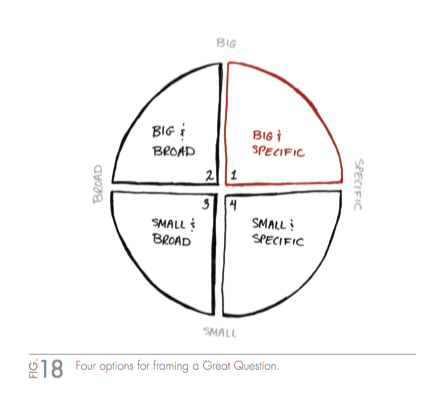In chapter 12 of The One Thing, Gary Keller and Jay Papasan introduce readers to four types of goals in what they describe as the question matrix. The idea is that if you ask the right question, you can find the motivation to pursue extraordinary results.
Many of us struggle with gaol setting because:
1. When we set goals, focus on something so achievable that it isn’t very motivating.
We don’t push ourselves to go further than what is possible for us right now and as a result we don’t push ourselves to learn more and try new things. So, we get the same results that we always get.
In other words, we set small goals instead of big goals.
2. Or we don’t set goals at all.
Instead, we just have basic directions. We want to achieve something life, but we don’t really have a line in the sand that says any achievement might be measured as a success or not. We know what we want, but we don’t really know what getting it will be like.
In other words, we set broad goals instead of specific goals.
Four Quadrants of Goal-Setting Questions
The authors divide the way we think about motivation into three quadrants:
- Big & Specific
- Big & Broad
- Small & Broad
- Small & Specific
Here is a figure from the book that shows these quadrants:
Source: The One Thing, Chapter 12
They provide a great example in the book for how to ask these different types of questions:
- BS: What can I do to double sales [big] in six months [specific]?
- BB: What can I do double sales [big, broad]?
- SB: What can I do increase sales [broad, small]?
- SS: What can I do to increase sales by 5% [small, specific] this year?
How to Get From Broad & Small to Big & Specific Goals
I got excited about this process and realized I need to think bigger in my own personal goals. When I sat down to write my questions, though, I struggled a little bit. I wasn’t sure how to come up with my Big and Specific question. So, I started from small and broad and worked my way up to big and specific.
Here are the questions I used to get from Broad & Small to Big & Specific. I think they will help you set Big & Specific goals too:
- What do you want to improve? (SB)
- What would be an achievable improvement? (SS)
- What would stretch you beyond what you think is possible? (SB)
- When will you aim to achieve this almost impossible improvement? (BS)
Then, when you are finished, write out your goal in a question:
- What can I do to improve (increase, help, show, reach, make, eliminate, etc.) . . . ?
For example, let’s say I felt that my One Thing was to write books. Let’s walk through each question:
1. What do you want to improve?
I want to write more books.
2. What would be an achievable improvement?
Improve from writing just one book a year to two books a year.
3. What would stretch you beyond what you think is possible?
Write five books in a year.
4. When will you aim to achieve this almost impossible improvement?
By this time next year.
Now put it together in a big and specific question:
What can I do to write five full length books by this time next year?
Why this Works
What I love about this process is the challenge it poses.
It is a lot like working out with a trainer or watching a workout video like Insanity. The trainer pushes you to work at at level you didn’t think was possible. Just when you think you have done the best you can do, they ask you to push through and do more.
The purpose of Big & Specific goal setting is to push you beyond where you are at today. In order to reach that Big & Specific goal, you will have to try new things to get there. You cannot continue to do the same actions and expect bigger and better results. Having a goal like this changes perspective, but more importantly it changes the actions we take to achieve our goals.
Writing five books in a year when you are only used to writing one book in a year is a big gap. In order to go from one to five books a year, you have to search for a different way of doing things. You have to go out and find new answers to this much more difficult question.
Where do you go for answers? You have to go to the experts and search for solutions to help you achieve that big, nearly impossible goal. You have to read books, articles, and blog posts to see what really works for people. With that specific date set, you know the clock is ticking and you have to work fast to find new answers and put them to the test. The date forces you to act quickly and efficiently in search of your answers.
Give this process a try. Pick the one thing you need to improve the most and go through these four questions to get to your Big & Specific goal.
Finding Your Answers
Readers of The One Thing know this is only the first half of the chapter. The second step after asking the right question is finding great answers.
If you liked this application of the book, then click on the link below and enter your email address to go further. I’ll send you the template I used to find my great answers to reach my Big & Specific Goals.
Download the Big & Specific Answers Worksheet



